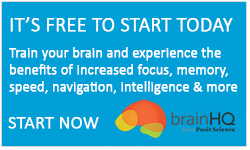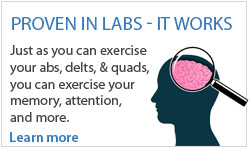BrainHQ is the only program that meets all requirements
Until recently, there haven’t been any good guidelines for choosing a brain-training program. But in 2015, the experts at the Institute of Medicine (now called the National Academy of Medicine) released an important report that included a five-item checklist to use to determine if a brain-training program is scientifically proven—or if it’s making claims it can’t back up.
To the best of our knowledge, BrainHQ is the only program that can check off all five of these questions, which include:
Question 1: Has the product demonstrated transfer of training to other laboratory tasks that measure the same cognitive construct as the training task?
For BrainHQ, the answer is YES.
The IMPACT study, led by researchers at Mayo Clinic and the University of Southern California, provides one great example. In the study, 487 people used BrainHQ exercises designed to improve memory. They got better at those exercises, which makes sense because they practiced them a lot. But the study participants also took standard tests of memory that were different from the exercises, and significantly improved on those, too.
When training gains “transfer” to standard tests of the same cognitive ability like this, it’s called “near transfer.” Near transfer has also been shown for BrainHQ in attention, processing speed, language, and more.
Question 2: Has the product demonstrated transfer of training relevant to real-world tasks?
For BrainHQ, again the answer is YES.
For instance, data from the ACTIVE study showed that training on the BrainHQ exercise Double Decision significantly improves driving safety and reduces the number real-world car crashes people have. The exercise was designed to train processing speed, not driving, but it affected the real-world skill of driving because processing speed is important when you’re behind the wheel.
When benefits transfer to completely different tasks than the one the exercise trains, it’s called “far transfer.” For BrainHQ exercises, far transfer has been shown not only in driving, but also in activities of daily living, depressive symptoms, health-related quality of life, predicted medical expenses, balance and fall risk, and more. This is important, and it’s a major difference between BrainHQ and other brain-training programs. Many of the criticisms of brain training say that there is no proof that it improves real-world skills. But more than a dozen published papers show that BrainHQ does.
Question 3: Has the product performance been evaluated using an active control group whose members have the same expectations of cognitive benefits as do members of the experimental group?
For BrainHQ, the answer is YES – many times.
For example, in the IHAMS study the experimental group used a BrainHQ exercise and the control group did crossword puzzles for an equal amount of time. Both groups thought they were doing something potentially good for their brains. The study showed that people who used BrainHQ significantly improved cognitive function, while the people in the crossword puzzle group did not.
Other active controls have been adult education, computer-use training, other types of cognitive training, driver education, and video games. All showed BrainHQ worked better.
Question 4: How long are the trained skills retained?
For BrainHQ, the answer is again YES.
Several studies have looked at whether benefits from using BrainHQ last, or if they fade away as soon as you finish training. The longest follow-up study so far showed that people still experienced a benefit even ten years after training.
Question 5: Have the purported benefits of the training product been replicated by research groups other than those selling the product?
For BrainHQ, the answer is again YES.
There are more than 100 published papers showing benefits from using BrainHQ exercises. Almost all of them were conducted by independent researchers from reputable universities and organizations, such as Johns Hopkins University, Yale University, the Department of Veterans Affairs, and the National Institutes of Health.
Although BrainHQ already fulfills each of the IoM’s requirements, we aren’t resting on our laurels: many more studies are currently underway. Our goal is to continually learn more about what BrainHQ can do and how to make it even better, so that we can provide a truly useful tool for cognitive health.






 English
English
 Français
Français


